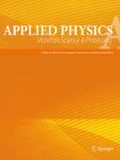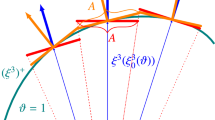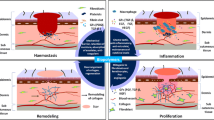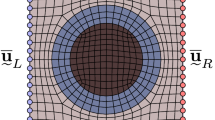Abstract
Skin is a living organ which can grow in a specific situation. In some cases, a defect like a wound or congenital nevus can bother the patients. Accordingly, the defect needs to be repaired with adjacent skin, and the growth phenomenon will be necessary in these conditions. Some studies have been done to model the growth of skin; however, none of them considered the viscoelastic property which is an inherent characteristic of the skin. Therefore, the main goal of this paper is to develop a nonlinear viscoelastic formulation for growing skin. The formulation is derived in such a way that the pure growth phenomenon can be recovered when the effect of viscoelasticity is ignored. Moreover, to deal with highly nonlinear formulation, a nonlinear finite element formulation in Total Lagrangian framework is developed. Furthermore, implicit trapezoidal time integration method is employed for evolution equations obtained from viscoelastic and growth contributions. Finally, some examples are provided to investigate the performance of the developed formulation and the good results compared to those available in the literature are obtained.










Similar content being viewed by others
References
M.Z. Albanna, J.H. Holmes, Skin tissue engineering and regenerative medicine (Academic Press, 2016)
C. Griffiths, J. Barker, T. Bleiker, R. Chalmers, D. Creamer, Rook’s textbook of dermatology (Wiley-Blackwell, Oxford, 2016)
R.J. Klebe, Cytoscribing: a method for micropositioning cells and the construction of two- and three-dimensional synthetic tissues. Exp. Cell. Res. 179, 362–373 (1988)
J.G. Beauchene, M.M. Chambers, A.E. Peterson, P.G. Scott, Biochemical, biomechanical, and physical changes in the skin in an experimental animal model of the therapeutic tissue expansion. J. Surg. Res. 47, 507–514 (1989)
A.B. Tepole, C.J. Ploch, J. Wong, A.K. Gosain, E. Kuhl, Growing skin: a computational model for skin expansion in reconstructive surgery. J. Mech. Phys. Solids. 59, 2177–2190 (2011)
C.G. Neumann, The expansion of an area of skin by progressive distension of a subcutaneous balloon; use of the method for securing skin for subtotal reconstruction of the ear. Plast. Reconstr. Surg. 19, 124–130 (1957)
K. Agrawal, S. Agrawal, Tissue regeneration during tissue expansion and choosing an expander. Indian J. Plast. Surg. 45, 7–15 (2012)
T. Richter, J.H. Müller, U.D. Schwarz, R. Wepf, R. Wiesendanger, Investigation of the swelling of human skin cells in liquid media by tapping mode scanning force microscopy. Appl. Phys. A 72, S125–S128 (2001)
M. Hollestein, A.E. Ehert, M. Itskov, E. Mazza, A novel experimental procedure based on pure shear testing of dermatome-cut samples applied to porcine skin. Biomech. Model. Mechanobiol. 10, 651–661 (2011)
G.C. Charalambopoulou, T.A. Steriotis, T. Hauss, K.L. Stefanopoulos, A.K. Stubos, A neutron-diffraction study of the effect of hydration on stratum corneum structure. Appl. Phys. A 74, S1245–S1247 (2002)
Y. Zhao, B. Feng, J. Lee, N. Lu, D.M. Pierce, A multi-layered computational model for wrinkling of human skin predicts aging effects. J. Mech. Behav. Biomed. Mater. 103, 103552 (2019)
T.K. Tonge, L.S. Altan, L.M. Voo, T.D. Nguyen, Full-field bulge test for planar anisotropic tissues: part I-experimental methods applied to human skin tissue. Acta Biomater. 9, 5913–5925 (2013)
L.K. Smalls, R. Wickett, M.O. Visscher, Effect of dermal thickness, tissue composition, and body site on skin biomechanical properties. Skin Res. Technol. 12, 43–49 (2006)
C. Pailler-Mattei, L. Laquieze, R. Debret, S. Tupin, G. Aimond, P. Sommer, H. Zahouani, Rheological behavior of reconstructed skin. J. Mech. Behav. Biomed. Mater. 37, 251–263 (2014)
S.H. Kim, J.M. Suk, Y.I. Lee, J. Kim, J.H. Lee, Identification of skin aging biomarkers correlated with the biomechanical properties. Skin Res. Technol. 27, 940–947 (2021)
N. Kumaraswamy, H. Khatam, G.P. Reece, M.C. Fingeret, M.K. Markey, K. Ravi-Chande, Mechanical response of human female breast skin under uniaxial stretching. J. Mech. Behav. Biomed. Mater. 74, 164–175 (2017)
G.G. Barbarino, M. Jabareen, E. Mazza, Experimental and numerical study on the mechanical behavior of the superficial layers of the face. Skin Res. Technol. 17, 434–444 (2011)
A.N. Kazerooni, A.R. Srinivasa, J.C. Criscione, A multinetwork inelastic model for the hysteretic response during cyclic loading of pig and rat skin. Int. J. Non-Linear Mech. 126, 103555 (2020)
R.D. Jobanputra, C.J. Boyle, D. Dini, M.A. Masen, Modelling the effects of age-related morphological and mechanical skin changes on the stimulation of tactile mechanoreceptors. J. Mech. Behav. Biomed. Mater. 112, 104073 (2020)
C. Flynn, A. Taberner, P. Nielsen, Mechanical characterisation of in vivo human skin using a 3D force-sensitive micro-robot and finite element analysis. Biomech. Model. Mechanobiol. 10, 27–38 (2011)
R.B. Groves, S.A. Coulman, J.C. Birchall, S.L. Evans, An anisotropic, hyperelastic model for skin: experimental measurements, finite element modelling and identification of parameters for human and murine skin. J. Mech. Behav. Biomed. Mater. 18, 167–180 (2013)
D.C. Pamplona, R.Q. Velloso, H.N. Radwanski, On skin expansion. J. Mech. Behav. Biomed. Mater. 29, 655–662 (2014)
A. Delfino, N. Stergiopulos, J.E. Moore, J.J. Meister, Residual strain effects on the stress field in a thick wall finite element model of the human carotid bifurcation. J. Biomech. 30, 777–786 (1997)
C. Guo, L. Yi, Y. Yu, J. Liu, Electrically induced reorganization phenomena of liquid metal film printed on biological skin. Appl. Phys. A 122, 1070 (2016)
D. Remache, M. Caliez, M. Gratton, S. Dos Santos, The effects of cyclic tensile and stress-relaxation tests on porcine skin. J. Mech. Behav. Biomed. Mater. 77, 242–249 (2018)
L. Socci, G. Rennati, F. Gervaso, P. Vena, An axisymmetric computational model of skin expansion and growth. Biomech. Model. Mechanobiol. 6, 177–188 (2007)
A.B. Tepole, A.K. Gosain, E. Kuhl, Stretching skin: the physiological limit and beyond. Int. J. Non-Linear Mech. 47, 938–949 (2012)
A.M. Zöllner, A.B. Tepole, A.K. Gosain, E. Kuhl, Growing skin: tissue expansion in pediatric forehead reconstruction. Biomech. Model. Mechanobiol. 11, 855–867 (2012)
A.M. Zöllner, A.B. Tepole, E. Kuhl, On the biomechanics and mechanobiology of growing skin. J. Theor. Biol. 297, 166–175 (2012)
A.B. Tepole, A.K. Gosain, E. Kuhl, Computational modeling of skin: using stress profiles as predictor for tissue necrosis in reconstructive surgery. Comput. Struct. 143, 32–39 (2014)
G.A. Holzapfel, T.C. Gasser, R.W. Ogden, A new constitutive framework for arterial wall mechanics and a comparative study of material models. J. Elast. 61, 1–48 (2000)
K.J. Bathe, Finite element procedures (Prentice Hall, 1996)
T.J. Hughes, The finite element method: linear static and dynamic finite element analysis (Courier Corporation, 2012)
T. Rabczuk, T. Belytschko, Cracking particles: a simplified meshfree method for arbitrary evolving cracks. Int. J. Numer. Methods in Eng. 61, 2316–2343 (2004)
V.P. Nguyen, T. Rabczuk, S. Bordas, M. Duflot, Meshless methods: a review and computer implementation aspects. Math. Comput. Simul. 79, 763–813 (2008)
T. Rabczuk, J.-H. Song, X. Zhuang, C. Anitescu, Extended finite element and meshfree methods (Academic Press, 2019)
N. Nguyen-Thanh, H. Nguyen-Xuan, S.P.A. Bordas, T. Rabczuk, Isogeometric analysis using polynomial splines over hierarchical T meshes for two-dimensional elastic solids. Comput. Methods Appl. Mech. Engrg. 200, 1892–1908 (2011)
G. Xu, M. Li, B. Mourrain, T. Rabczuk, J. Xu, S. Bordas, Constructing IGA-suitable planar parameterization from complex CAD boundary by domain partition and global/local optimization. Comput. Methods Appl. Mech. Eng. 328, 175–200 (2018)
V.P. Nguyen, C. Anitescu, S.P.A. Bordas, T. Rabczuk, Isogeometric analysis: an overview and computer implementation aspects. Math. Comput. Simul. 117, 89–116 (2015)
G.D. Huynh, X. Zhuang, H.G. Bui, G. Meschke, H. Nguyen-Xuan, Elasto-plastic large deformation analysis of multi-patch thin shells by isogeometric approach. Finite Elem. Anal. Des. 173, 103389 (2020)
V.M. Nguyen-Thanh, X. Zhuang, T. Rabczuk, A deep energy method for finite deformation hyperelasticity. Eur. J. Mech. A Solids 80, 103874 (2020)
E. Samaniego, C. Anitescu, S. Goswami, V.M. Nguyen-Thanh, H. Guo, K. Hamdia, T. Rabczuk, X. Zhuang, An energy approach to the solution of partial differential equations in computational mechanics via machine learning: concepts, implementation and applications. Comput. Methods Appl Mech Engrg 362, 112790 (2020)
V.M. Nguyen-Thanha, C. Anitescu, N. Alajlan, T. Rabczuk, X. Zhuang, Parametric deep energy approach for elasticity accounting for strain gradient effects. Comput. Methods Appl. Mech. Engrg. 386, 114096 (2021)
Y.C. Fung, Biomechanics: mechanical properties of living tissues (Springer, New York, 1981)
A. Lion, On the large deformation behaviour of reinforced rubber at different temperatures. J. Mech. Phys. Solids. 45, 1805–1834 (1997)
P. Haupt, K. Sedlan, Viscoplasticity of elastomeric materials. Experimental facts and constitutive modeling. Arch. Appl. Mech. 71, 89–109 (2001)
E.K. Rodriguez, A. Hoger, A.D. McCulloch, Stress-dependent finite growth in soft elastic tissues. J. Biomech. 27, 455–467 (1994)
Y. Lanir, Y.C. Fung, Two-dimensional mechanical properties of rabbit skin. II. Experimental results. J. Biomech. 7, 171–182 (1974)
M. Rausch, E. Kuhl, On the mechanics of growing thin biological membranes. J. Mech. Phys. Solids. 63, 128–140 (2014)
R. Rivera, J. LoGiudice, A.K. Gosain, Tissue expansion in pediatric patients. Clin. Plast. Surg. 32, 35–44 (2005)
A.K. Gosain, C.G. Zochowski, W. Cortes, Refinements of tissue expansion for pediatric forehead reconstruction: a 13-year experience. Plast. Reconstr. Surg. 124, 1559–1570 (2009)
A. Lubarda, A. Hoger, On the mechanics of solids with a growing mass. Int. J. Solids Struct. 39, 4627–4664 (2002)
H. Xiao, O.T. Bruhns, A. Meyers, Logarithmic strain, logarithmic spin and logarithmic rate. Acta Mech. 124, 89–105 (1997)
P. Wriggers, Nonlinear finite element methods (Springer-Verlag, 2008)
Author information
Authors and Affiliations
Corresponding author
Ethics declarations
Conflict of interest
The authors report there are no competing interests to declare.
Additional information
Publisher's Note
Springer Nature remains neutral with regard to jurisdictional claims in published maps and institutional affiliations.
Rights and permissions
Springer Nature or its licensor holds exclusive rights to this article under a publishing agreement with the author(s) or other rightsholder(s); author self-archiving of the accepted manuscript version of this article is solely governed by the terms of such publishing agreement and applicable law.
About this article
Cite this article
Firouzi, N., Dadgar-Rad, F. & Falahatgar, S.R. On viscoelastic deformation of growing skin in reconstructive surgery. Appl. Phys. A 128, 931 (2022). https://doi.org/10.1007/s00339-022-06047-1
Received:
Accepted:
Published:
DOI: https://doi.org/10.1007/s00339-022-06047-1




